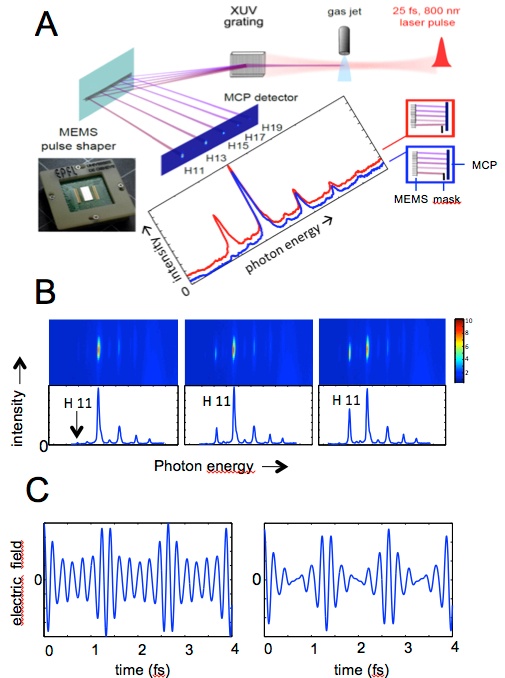Hans Jakob Wörner / Jean-Pierre Wolf and co-workers: Direct Amplitude Shaping of High Harmonics in the Extreme Ultraviolet
February 15, 2013Direct shaping of attosecond pulse trains after their generation using a reflective micromirror array based on micro-electro-mechanical-system (MEMS) technology
In the XUV, waveform control of attosecond pulses and high-harmonics (HH) was limited to some indirect manipulation of the HH generation process, so that complete control of phase and amplitude of each harmonic individually was impossible. In the framework of our MUST-collaboration, we recently demonstrated direct shaping of attosecond pulse trains after their generation using a reflective micromirror array based on micro-electro-mechanical-system (MEMS) technology. We showed independent control over the intensity of each high harmonic (H11 to H23) in the observed range (14-36 eV), resulting in extensive control over the temporal structure of the attosecond pulses in the train.
As next step, we will investigate the applications of shaped XUV waveforms in experiments on electron dynamics in atoms and molecules. The role of both amplitude and phase shaping will be studied by reflecting the XUV spectrum back onto the concave grating using a reflective 4f-configuration in order to recombine the modulated spectral components. Our work might lay the foundations for the first coherent control experiments of core and valence electrons on attosecond timescales.
Further readings: “Direct Amplitude Shaping of High Harmonics in the Extreme Ultraviolet”, D. Kiselev, P. M. Kraus, L. Bonacina, H.J. Wörner, J.P. Wolf, OpticsExpress 20(23), 25843-25849 (2012)

Figure: (A) High-harmonic pulse shaping experiment in the XUV: The HH generated in the gas jet are spectrally dispersed and focused onto a MCP detector via a reflective linear micromirror array (MEMS), which can individually control the reflection angle of each HH separately and deviate it onto a spatial filter (mask). The red line shows the unshaped spectrum (shifted vertically for clarity) and the blue line shows maximal attenuation of H11. (B) Progressive amplitude shaping of H11 from 0 to 100%, by tilting 0, 2 and 6 mirrors (from left to right) (C) Temporal waveforms assuming a flat spectral phase corresponding to the left-most spectrum in panel B (maximal attenuation of H11) or to the right-most spectrum in panel B (no attenuation of H11)
<<

 Ursula Keller wins “Swiss Nobel” Marcel Benoist Prize
Ursula Keller wins “Swiss Nobel” Marcel Benoist Prize Farewell: the NCCR MUST ended
Farewell: the NCCR MUST ended  MUST2022 Conference
MUST2022 Conference New scientific highlights
New scientific highlights FELs of Europe prize for Jeremy Rouxel
FELs of Europe prize for Jeremy Rouxel Ruth Signorell wins Doron prize
Ruth Signorell wins Doron prize New FAST-Fellow Uwe Thumm at ETH
New FAST-Fellow Uwe Thumm at ETH International Day of Women and Girls in Science
International Day of Women and Girls in Science New scientific highlight
New scientific highlight EU XFEL Young Scientist Award for Camila Bacellar,
EU XFEL Young Scientist Award for Camila Bacellar, Prizes for Giulia Mancini and Rebeca Gomez Castillo
Prizes for Giulia Mancini and Rebeca Gomez Castillo Nobel Prize in Chemistry awarded to RESOLV Member Benjamin List
Nobel Prize in Chemistry awarded to RESOLV Member Benjamin List Hans Jakob Wörner invited to give the „New Horizons Solvay Lectures”
Hans Jakob Wörner invited to give the „New Horizons Solvay Lectures”  Unusual keynote talk at an international scientific conference
Unusual keynote talk at an international scientific conference NCCR MUST at Scientifica 2021
NCCR MUST at Scientifica 2021